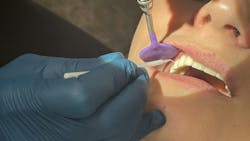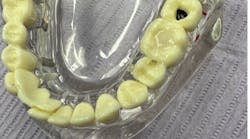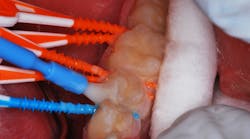Rethinking silver diamine fluoride in cosmetic restorative dentistry
Silver diamine fluoride (SDF) is often associated with pediatric and geriatric care, where caries arrest and patient management needs take priority over esthetics. Consequently, many dentists practicing in esthetically driven environments assume SDF has no place in their practices. The rationale is understandable: SDF darkens carious lesions to an unsightly brown or black color, which seems incompatible with the goals of cosmetic dentistry.
However, as a prosthodontist, I argue that this assumption is outdated. With proper case selection and integration protocols, SDF can become a valuable clinical and business tool—even in a practice focused on esthetics. In fact, strategic use of SDF improves diagnostic precision, enhances prevention, and stabilizes carious teeth, all without compromising patient satisfaction.
SDF during hygiene visits
The most effective place to implement SDF is the dental hygiene department. Studies have shown that SDF can arrest 81% of active caries lesions after one application, with improved outcomes with subsequent applications.1
Hygienists can apply SDF interproximally using SuperFloss or a fine microbrush. On posterior teeth, this often results in no visible discoloration, making it ideal for areas where esthetics are not a concern. In anterior cases, if the lesion is visible and staining would compromise appearance, alternative treatments might be considered. For pit and fissure caries, where stains may already be present, SDF does not worsen the esthetic outcome and may prevent further structural degradation, while preserving healthy tooth structure.
Bridging treatment gaps
SDF is valuable in managing the pace of disease progression when restorative treatment is phased, as it buys time. Application to untreated sites reduces the progression of decay while the clinician addresses other priorities.2 This helps maintain case stability and minimizes surprises during later phases of care.
Moreover, SDF is a helpful diagnostic adjunct. When there is uncertainty about whether a lesion warrants surgical intervention, SDF application provides clarity. Healthy enamel does not stain with silver ions; active carious dentin does.3 This visual feedback guides clinical decision-making, reduces overtreatment, and supports the philosophy of conservative, biologically responsible care.
Smart restorative choices
For deeper carious lesions where conservative excavation is planned, SDF is useful intraoperatively following partial caries removal. When followed by the placement of a glass-hybrid restoration, this combination has been shown to strengthen the tooth-restoration interface.4 The silver ions in SDF promote antimicrobial activity and the formation of reparative dentin, while glass-hybrid materials support remineralization and a long-term seal. This aligns well with modern principles of minimally invasive dentistry and provides a functional, esthetic, and biologically stable solution for patients with high caries risk, financial constraints, or to provide pulpal protection.
Incorporating SDF into practice is clinically and financially beneficial. In my practice, we charge a per-tooth fee for SDF application at all dental hygiene visits. This is a billable procedure distinct from fluoride varnish, and both may be applied in the same visit. Some third-party payers reimburse for SDF under specific guidelines,5 but understanding plan details is crucial for accurate coding and transparent patient communication. Patient acceptance has been high. When we explain the benefits, risks, and rationale clearly, emphasizing that it preserves tooth structure and can delay or avoid more invasive treatment, most patients are receptive.
Silver diamine fluoride is more versatile than many cosmetic dentists believe. With thoughtful application, it supports the goals of esthetic and conservative dentistry.
Editor's note: This article appeared in the May 2025 print edition of Dental Economics magazine. Dentists in North America are eligible for a complimentary print subscription. Sign up here.
References
- Horst JA, Ellenikiotis H, Milgrom PL. UCSF protocol for caries arrest using silver diamine fluoride: rationale, indications, and consent. J Calif Dent Assoc. 2016;44(1):16-28.
- Crystal YO, Niederman R. Evidence-based dentistry update on silver diamine fluoride. Dent Clin North Am. 2019;63(1):45-68. doi:10.1016/j.cden.2018.08.011
- Mei ML, Li QL, Chu CH, Yiu CKY, Lo ECM. The inhibitory effects of silver diamine fluoride at different concentrations on matrix metalloproteinases. Dent Mater. 2012;28(8):903-908. doi:10.1016/j.dental.2012.04.011
- Ngo H, Mamorita M, Chrzanowski W, et al. Bioactive materials in dentistry. Int J Biomater. 2018;2018:1-2.
- American Dental Association. CDT 2024: Dental Procedure Codes. American Dental Association; 2023.
About the Author
Pamela Maragliano, DMD
Chief Editor of Dental Economics
Pamela Maragliano, DMD, is the chief editor of Dental Economics. Based in Salem, Massachusetts, Dr. Maragliano began her clinical career as a dental hygienist. She went on to attend Tufts University School of Dental Medicine, where she earned her doctorate in dental medicine. She then attended the University of California, Los Angeles, School of Dental Medicine, where she became board-certified in prosthodontics. Dr. Maragliano owns a private practice, Salem Dental Arts, and lectures on a variety of clinical topics. You may contact her at [email protected].



